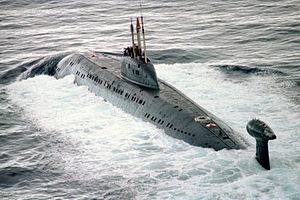Victor-class submarine
 A Victor III class submarine on the surface.
| |
| Class overview | |
|---|---|
| Builders | Soviet Union |
| Operators | list error: <br /> list (help) |
| In service | 1967 |
| In commission | November 5, 1967 |
| Completed | 49[1] |
| General characteristics | |
| Displacement | 4,950 tons light surf.; 6,990 tons normal surf./7,250 tons sub. |
| Length | 93 to 102 meters (303 to 335 feet) |
| Beam | 10 m (33 ft) |
| Draft | 7 m (24 ft) |
| Propulsion | 2 VM-4P pressurized-water nuclear reactors (75 Mw each), 2 sets OK-300 steam turbines; 1 7-bladed prop; 31,000
shp at 290 shaft rpm—2 low-speed electric cruise motors; 2 small props on stern planes; 1,020 shp at 500 rpm Electric: 4,460 kw tot. (2 × 2,000-kw, 380-V, 50-Hz a.c. OK-2 turbogenerators, 1 × 460-kw diesel emergency set) |
| Endurance | 80 days |
| Complement | 27 officers, 34 warrant officers, 35 enlisted |
| Sensors and processing systems | Radar: 1 MRK-50 Albatros’-series (Snoop Tray-2) nav./search
Sonar: MGK-503 Skat-KS (Shark Gill) suite: LF active/passive; passive flank array; Barrakuda towed passive linear array; MT-70 active ice avoidance EW: MRP-10 Zaliv-P/Buleva (Brick Pulp) intercept; Park Lamp D/F |
| Armament | 2 bow 650-mm TT (8 Type 88R/SS-N-16 Stallion missiles and/or Type 65-76 torpedoes); 4 bow 533-mm TT (16
Type 83RN and 84RN/SS-N-15 Starfish and Type 53-65K and USET-80 torpedoes, VA-111 Shkval rocket torpedoes, MG-74 Korund and Siren decoys, or up to 36 mines) |
The Victor class (Russian name Project 671 Shchuka (Pike) is the general NATO classification for a type of nuclear-powered submarine that was originally put into service by the Soviet Union around 1967. In the USSR, they were produced under Project 671. Victor-class subs featured a teardrop shape, which allowed them to travel at high speed. These vessels were primarily designed to protect Soviet surface fleets and to attack American ballistic missile subs, should the need ever arise.
Versions
Three versions of Victor-class subs existed:
Victor I
Victor I - Soviet designation Project 671 Yorzh (Rufe) - was the initial type that entered service in 1967; 16 were produced. Each had 6 tubes for launching Type 53 torpedoes and SS-N-15 cruise missiles, and mines could also be released. Subs had a capacity of 24 tube-launched weapons or 48 mines (a combination would require less of each).
Victor II
Victor II - Soviet Designation Project 671RT Syomga (a type of Salmon)- entered service in 1972; 7 or more were produced in the 1970's. These were originally designated Uniform class by NATO. They had similar armament to Victor I. The Soviet Union discovered through its spy network that Americans could easily track Victor II-class subs and subsequently halted production of this type to design the Victor III class.
Victor III
Victor III - Soviet Designation Project 671RTM Shchuka (Pike) - entered service in 1979; 25 or 26 were produced until 1991. Quieter than previous Soviet submarines, these ships had 2 tubes for launching SS-N-21 or SS-N-15 missiles and Type 53 torpedoes, plus another 4 tubes for launching SS-N-16 missiles and Type 65 torpedoes. 24 tube-launched weapons or 36 mines could be on-board. The Victor-III caused a minor furore in NATO intelligence agencies at its introduction because of the distinctive pod on the vertical stern-plane. Speculation immediately mounted that the pod was the housing for some sort of exotic silent propulsion system, possibly a Magnetohydrodynamic drive unit. Another theory proposed that it was some sort of weapon system. In the end, the Victor-III's pod was identified as a hydrodynamic housing for a reelable towed passive sonar array; the system was subsequently incorporated into the Sierra-class and Akula-class SSNs.
Active submarines:
B-388 Sosnovy Bor
B-414 Daniil Moskovsky
K-448 Tambov
B-138 Polyarnye Zori
-
Victor I class, without the 'distinctive pod' yet. Compare to photo at the top of this article.
Incidents
- On 10 August 1985, while being refueled at the Chazhma Bay naval yard outside Vladivostok, K-314 suffered an uncontrolled criticality event when the reactor lid was raised, incorrectly removing the reactor's control rods. The resulting explosion killed ten shipyard workers and released large amounts of radioactive material, contaminating an area 6km (3.6 miles) in length on the Shotovo Peninsula and the sea outside the naval yard.
- On September 6, 2006, a Victor III Daniil Moskovskiy suffered an electronics fire while in the Barents Sea, killing two crew members. The boat was 16 years old and overdue for overhaul. It was towed back to Vidyayevo.[2][3]
General characteristics
- Length: 93 to 102 meters (303 to 335 feet)
- Beam: 10 m (33 ft)
- Draft: 7 m (24 ft)
- Displacement: 6,085 tons to 6,990 tons
- Propulsion:
- 2 VM-4 pressurized-water reactors
- 1 propeller
- Crew: about 100
- Armament:
- 6 torpedo tubes
- cruise missiles
- mines
- Speed: 56 km/h (32 knots/35 mph)
- Commissioned: November 5, 1967
Notes
References
- National Geographic: Victor class accessed March 14, 2004.
- NATO Code Names for Submarines and Ships accessed March 14, 2004.
- Article in Russian Language on Victor I
- Article in Russian Language on Victor II
- Article in Russian Language on Victor III
- Article in English from FAS
- Fire breaks out aboard Northern Fleet nuclear sub, killing 2

